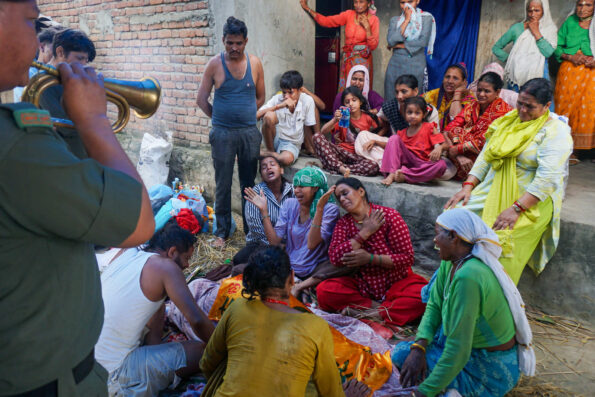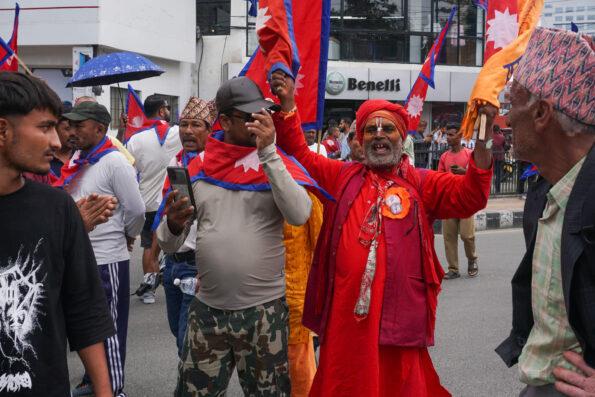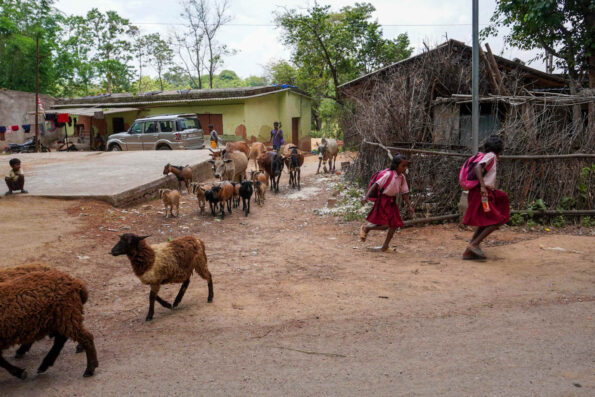
Gabriela Meléndez Rivera, GPJ Puerto Rico
Flor-Angel Guilbe Stevens looks at a photo on her cellphone while styling the hair of Perla del Mar, her 8-year-old daughter, at their home in Juana Díaz, Puerto Rico. Guilbe has embraced the natural hair movement in her country, celebrating her and her daughter’s blackness.
JUANA DÍAZ, PUERTO RICO — The scene is the same every Sunday. “Lower your head, precious,” Flor-Angel Guilbe Stevens says, hands full of moisturizing cream. One by one, she twists dreadlocks, tangling together and growing naturally without the use of brushes or scissors. This is the hair of Perla del Mar, her 8-year-old daughter. Soon, an aroma announces that Perla’s grandmother has finished filtering coffee and it is time to take a break.
Guilbe has been laboring over her daughter’s locks for more than an hour. It is almost the same ritual she experienced during her childhood in the 1990s, except that relaxers were applied to her hair, and it was styled with a blow-dryer or set in curlers, all to keep it “under control”. When she entered university, she questioned the imposition of straight hair with which Afro-descendant women were growing up and decided to keep her hair natural.


Guilbe, a 36-year-old preschool teacher living in Juana Díaz, is one of the many voices in Puerto Rico who, through reconciling with their hair and consequently their racial identity, are practicing a type of motherhood that celebrates blackness starting in childhood. Now, a new generation of children is proudly keeping their hair natural as an expression of their identity.
In some school and work environments, however, hairstyles associated with blackness, such as Afros, dreadlocks or braids, are still prohibited because they are treated as inappropriate, which is the impetus behind legislation that would eradicate this form of discrimination.
“The relaxer burned”
Perla’s grandmother, Amled Stevens, 66, is a retired pharmacist. In a photo of herself at a primary school graduation ceremony — she cannot remember if it was for kindergarten or first grade — her hair was already straightened. Her skin’s memory does not fail her: “The relaxer burned,” she says. Her mother, whom she calls Mami Delma, never spoke about the possibility of having natural hair or an Afro. For Stevens, in the 1970s, it was rare to see people with Afros in Ponce, the city where she was raised and where she lives. “Ponce was extremely difficult for black people. Many people there were rich and white.”
Stevens had her daughter at the age of 30. “She was beautiful and very small,” she recalls. Upon doing her hair at the age of 5, she relied on what she knew: a relaxer. “It came from the love of a mother,” Guilbe says. “She was trying to protect me based on what she understood to be the best thing for me.”
In Puerto Rico, where multiple races — indigenous, Spanish and African — have mixed for centuries, the concept of blackness is complicated, says Bárbara Abadía-Rexach, an anthropologist, activist and member of Colectivo Ilé, a decolonial organization that works to eradicate systemic racial discrimination. “Puerto Rico is an Afro-descendant country, but not everyone is treated as black,” she says. “If a problem isn’t recognized, we have nothing to resolve.”



The census of Puerto Rico did not ask about racial identity until 2000, when it began to use the same questionnaire as the United States census. “Here, labels were imposed that did not correspond to our racial understanding,” says María Reinat-Pumarejo, an educator, community organizer and anti-racism activist.
That year, 81% of the population identified as “white.” Anti-racism organizations launched educational campaigns so that, before filling out the questionnaire, people would reflect on how Puerto Ricans were racialized. Consequently, in 2010, when the census was taken again, the number of “white” people fell to 76%. And in 2020, it plummeted to 17%, with half of the population identifying as having “two or more races.” The census category “black or African American (alone or combined)” reached 18%.
“The results were very significant: They account for a recognition of blackness,” Abadía-Rexach says. Hair, just like skin color, cannot be hidden. It is one of the principal markers of blackness. Civil rights movements in the US along with the back-and-forth of Puerto Ricans between the Caribbean and North America have had an impact on the acceptance of Afro-descendant hair.
“Identifying as Afro-descendant”
At the age of 19, Guilbe picked up a pair of scissors and cut off the straightened sections of her hair. The result was a short, curly Afro. “I didn’t feel black until I cut my hair,” she says. Her arrival at the Río Piedras campus of the University of Puerto Rico influenced her decision. She studied preschool education there and took theater classes. María Cotto, “La Cotto,” a drama student and now a singer and rapper, would walk by her class with natural hair. She was one of Guilbe’s first role models.
Guilbe learned how to comb and style her hair, to moisturize it with cream and perfectly maintain each curl. “It’s a process of acceptance and of finding yourself and identifying as Afro-descendant,” she says. From keeping her hair natural she went on to dance and later sing bomba, an Afro-Caribbean genre historically played by people who were enslaved. It has now become a cultural manifestation of Afro-descendant people. “Bomba got me to empower myself and create an identity,” she says.
Many Puerto Rican women have opted to affirm and preserve their blackness by revaluing cultural expressions, writes anthropologist Hilda Lloréns in the academic journal Latin American and Caribbean Ethnic Studies. Lloréns says these manifestations, like bomba, are a form of resistance and can become spaces of pride.



The natural hair movement is not new, but it has grown in popularity, says Vimarie Santiago, a stylist who works on natural hair. Santiago says the way her clients, the mothers, care for the hair of their daughters and sons “can develop within them a love for their hair.”
When Guilbe had Perla at 28, she dreamed of giving her an Afro like hers, but it did not turn out that way. “She suffered when we had to comb her hair, and I didn’t want her to associate hair with torture,” she says. During her first three years, Perla’s hair started to form dreadlocks, and Guilbe decided to let them grow. She looked up videos, learned how to treat them and even adopted them for her own hair.
“I did dreads to understand and experience what she is experiencing,” she says. “I feel I’m supporting her in the process. It’s something that’s very unique to us. Not everyone experiences it.”
Hair that goes against the current
On May 3, Bill 1282 was approved without amendments to be voted on by the House of Representatives of Puerto Rico. Introduced by Alanis Ruiz Guevara, it seeks to create a “law against discrimination based on hairstyles.”
Ruiz is an activist who participated in AfroJuventudes, an anti-racism school founded by Colectivo Ilé and the magazine Revista étnica, which raises awareness about Afro-Latino communities. She has stated that she is not alone in her experience of isolation and discrimination. “People do not understand that there is a correlation between our hair and our identity. And maybe we weren’t born with braids or dreadlocks, but they do have spiritual and ancestral representation,” she says. If approved by the House, the bill will go to the governor’s office.



“This bill is important because children and other young people who are growing up will be able to wear their braids and Afro-descendant hair, and they’ll never have to question themselves about whether it’s OK. They will be able to appreciate what their blackness and ancestry are without doubting them,” Ruiz says.
Lines of color, letters from the alphabet and a phrase saying “Mommy is the best” decorate the walls of Guilbe’s house. Perla wears her dreads a little below her shoulders. She has five favorite colors: pink, purple, blue, white and green. She drinks coffee with milk and draws a rainbow. She does not hesitate to express herself when she disagrees with something. “She visibly recognizes herself as black,” Guilbe says. “I didn’t visibly recognize myself as black. I achieved that, and I feel proud.”
She finishes doing her daughter’s hair and covers her face with kisses. Perla runs to the mirror to take in the shimmering pink beads woven into her dreadlocks. “Seeing her happy with her hair,” Guilbe says, “makes me feel it has been worth it to go against the current.”
Gabriela Meléndez Rivera is a Global Press Journal associate reporter based in Vega Baja, Puerto Rico.
TRANSLATION NOTE
Shannon Kirby, GPJ, translated this story from Spanish.







